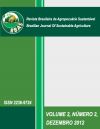SOCIAL CAPITAL AND SOCIO-ECONOMIC PERFORMANCE: THE TECHNOLOGICAL MATRIX IN THE SETTLEMENT CAPELA, RS
DOI:
https://doi.org/10.21206/rbas.v2i2.164Abstract
This work, through interdisciplinary stage of living, aimed to analyze the changes in the settlement Capela after the formation of the cooperative. The settlement Capela is located southwest of River Caí, 15 Km north of the city of Santa Maria in Rio Grande do Sul, Brazil. This settlement has 100 families distributed over an area o 2,169.37 ha. Of this total, the others are organized into individual lots and the rest make up the framework of cooperative production - COOPAN - existing since the creation by the settlers of ecosystems to produce healthy foods free of pesticides and genetically modified organisms, becoming the guiding technological matrix of the production system. The thirty families that are part of COOPAN joined in changing production systems, or else, they started to produce rice, vegetables, and animals created in pastures without use of agrochemicals. The aim of each settlement was to develop a mindset and an attitude of food sovereignty. Understanding that social function of land is to produce food, COOPAN along with other cooperative movement in the southern country is seeking space in the market through the insertion of organic products from the land reform. The study suggests that COOPAN represents, under the agrarian reform a key strategy for the accumulation of socioeconomic performance of the settler families.Downloads
Download data is not yet available.
Downloads
Published
2012-12-01
How to Cite
Deyvison Lopes Siqueira Dinamene Boavent, Frederico Antonio Mineiro Lopes, Helder dos Anjos Augusto, & Deyvison Lopes Siqueira. (2012). SOCIAL CAPITAL AND SOCIO-ECONOMIC PERFORMANCE: THE TECHNOLOGICAL MATRIX IN THE SETTLEMENT CAPELA, RS. Brazilian Journal of Sustainable Agriculture, 2(2). https://doi.org/10.21206/rbas.v2i2.164
Issue
Section
Artigos
License
1. Proposta de Política para Periódicos de Acesso Livre
Autores que publicam nesta revista concordam com os seguintes termos:
Autores mantém os direitos autorais e concedem à revista o direito de primeira publicação, com o trabalho simultaneamente licenciado sob a Licença Creative Commons Attribution que permite o compartilhamento do trabalho com reconhecimento da autoria e publicação inicial nesta revista.












